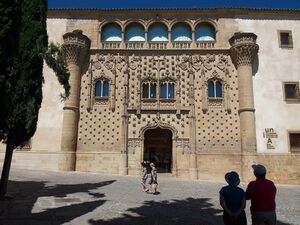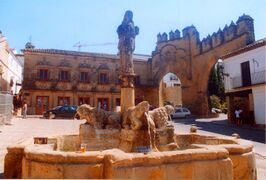بياسة
Baeza | |
|---|---|
 | |
| الإحداثيات: 37°59′N 3°28′W / 37.983°N 3.467°W | |
| Country | |
| Autonomous community | |
| Province | Jaén |
| Comarca | La Loma |
| Judicial district | Baeza |
| الحكومة | |
| • Mayor | Leocadio Marín Rodríguez (PSOE) |
| المساحة | |
| • الإجمالي | 194٫3 كم² (75�0 ميل²) |
| المنسوب | 769 m (2٬523 ft) |
| التعداد (2009) | |
| • الإجمالي | 16٬253 |
| • الكثافة | 84/km2 (220/sq mi) |
| صفة المواطن | Baezanos |
| منطقة التوقيت | UTC+1 (CET) |
| • الصيف (التوقيت الصيفي) | UTC+2 (CEST) |
| Postal code | 23440 |
| الموقع الإلكتروني | Official website |
| Renaissance Monumental Ensembles of Úbeda and Baeza | |
|---|---|
 | |
| أسس الاختيار | Cultural: ii, iv |
| المراجع | 522 |
| Inscription | 2003 (27th Session) |
بلدية بياسة[1][2] (بالإسبانية: Baeza) هي بلدية تقع في مقاطعة خاين التابعة لمنطقة أندلوسيا جنوب إسبانيا.
It is now principally famed for having some of the best-preserved examples of Italian Renaissance architecture in Spain. Along with neighbouring Úbeda, it was added to UNESCO's list of World Heritage Sites in 2003. The former Visigothic bishopric of Baeza remains a Latin Catholic titular see.
Geography
The town lies perched on a cliff in the range (the Loma de Úbeda) separating the Guadalquivir River to its south from the Guadalimar to its north.[3]
History
The town stands at a high elevation about 3 ميل (4.8 km) from the right bank of the Guadalquivir[4] in the Loma de Úbeda.[5] Under the Romans, the town was known as 'Beatia'.[4] Following its conquest by the Visigoths, Beatia was the seat of a bishopric of Baeza (viz.). From the beginning of the seventh century it was conquered by several Arab and berber states during the Al-Andalus period, being named Bayyasa.
The Christian diocese was reestablished in 1127 or 1147[بحاجة لمصدر] following the town's conquest by Alfonso VII of Castile, but it was then again reconquered by the Almohads. After the Battle of Las Navas de Tolosa, Ferdinand III of Castile in 1227 retook the city and gave it the Fuero de Cuenca, a legislative body, to facilitate the new Castilian order and institutions.
For the rest of the middle ages, Baeza remained together with Jaén, Úbeda and Andújar among the dominant cities in the Kingdom of Jaén, although the 1248 conquest of Jaén tended to favour the fortunes of that city, that enjoyed a strategic location vis-à-vis the Kingdom of Granada.[6]
الديموغرافيا
بلغ عدد سكان بلدية بياسة 16.411 نسمة عام 2011 (وفقاً للمعهد الوطني للإحصاء الإسباني).[7]
| التطور الديمغرافي في بياسة | |||||||||||||||||||
|---|---|---|---|---|---|---|---|---|---|---|---|---|---|---|---|---|---|---|---|
| 1996 | 1999 | 2002 | 2005 | 2007 | 2009 | 2011 | |||||||||||||
| 16.012 | 15.841 | 15.223 | 15.880 | 16.135 | 16.253 | 16.411 | |||||||||||||
المعالم
Baeza still houses several fine public buildings:
- Natividad de Nuestra Señora Cathedral, presents an early Gothic and Plateresque pilasters and crossed vaults finished in the sixteenth century in a Renaissance style by renamed architect Andrés de Vandelvira, and since 1584 by architect and mathematician Juan Bautista Villalpando. The tower was redone in 1549 and the Chapel of St Michael was added in 1560.
- Town Hall (Ayuntamiento), a Plateresque building originally built as a combined courthouse and prison, leading to two separate main entrances
- Baeza University, established in 1533[4] or 1538,[بحاجة لمصدر] now a secondary school
- Santa Cruz Church, a Romanesque church with a two-aisle nave and semicircular apse. A side wall incorporates a Visigothic arch.
- St Paul's Church, a Gothic church with a Renaissance portal with a two-aisle nave and Gothic chapels. Includes the tomb of Pablo de Olavide.
- The Chapel of St Francis, in the ruins of a Renaissance building from 1538 formerly used as a monastery[5]
- Jabalquinto Palace (Palacio de Jabalquinto), including an Gothic entrance flanked by two cylindrical pilasters with Plateresque capitals with mocárabes ornamentation, a Renaissance courtyard, and a Baroque staircase
- Spain Plaza (Plaza de España)
- Constitution Plaza (Plaza or Paseo de la Constitucíon), including a marble fountain decorated with Caryatides[4]
- St Mary Fountain (1564)
- The Fountain of the Lions, from the Ibero-Roman ruins of Cástulo and possibly representing Himilce, wife of the Carthaginian general Hannibal
- The Úbeda Gate and Jaén[4] Gate.
- The Villalar Arch (Arco de Villalar), erected for Charles V's 1526 visit to honor his 1521 victory at Villalar.
- Seminary oratorio of St Philip Neri[4] (1660)
النقل
Baeza is 327 km (203 mi) south of Madrid by highway. The Linares–Baeza RENFE railway station is 15 km (9 mi) away to the southwest; it lies on the Linares-Almeria line. There are bus connections to Granada, Málaga, and Madrid. Granada (132 km أو 82 mi) and Málaga (241 km أو 150 mi) are the nearest international airports.
أبرز السكان
- البياسي، أديب أندلسي.
- سارو، أسقف (ح. 862)
- Domingo, bishop (1236–1249), Dominican friar, and former bishop of Marocco from 27 October 1225 – 1236
- گاسپار بسرا, نحات ورسام[8]
- St John of Ávila, Christian mystic[9][10]
- St John of the Cross, Christian mystic[11]
- Pablo de Olavide[12][13]
- Antonio Machado, modernist poet whose most notable prose work Juan de Mairena is thought to have been inspired by his time as a teacher in Baeza (1912–1919)
- Ginés Martin de Aranda, designer of the Fountain of Mary in the square of Baeza. He also contributed to some of the works of the Cathedral of Baeza.
العلاقات الدولية
Baeza is twinned with:
 Carcassonne, France[14]
Carcassonne, France[14]
معرض صور
انظر أيضاً
مراجع
- ^ «بيّاسة بالأندلس أيضاً: بينها وبين جيان عشرون ميلاً، وكل واحدةٍ منهما تظهر من الأخرى؛ وبياسة على كديةٍ من تراب، مطلة على النهر الكبير المنحدر إلى قرطبة، وهي مدينة ذات أسوارٍ وأسواقٍ ومتاجر، وحولها زراعات، ومستغلات الزعفران بها كثيرة. وفي سنة 623، مَلَكَ الروم بياسة يوم عرفة من ذي حجتها، وكان صاحب جيان إذ ذاك عبد الله بن محمد بن عمر بن عبد المؤمن، قد تغير له عبد الله العادل بن المنصور، صاحب إشبيلية، فخافه فخرج إلى بياسة ودخلها، وكلم أهلها في مساعدته وامتناعه بهم، إلى أن يأخذ لنفسه الأمان، فساعدوه على مراده، ومنعوه عن رأيه، فجهز إليه العادل العساكر، وقدم عليهم إدريس بن المنصور. فلما نزلوا بظاهر بياسة مكثوا عليها أياماً، والزمان شاتٍ، فلم يغنوا شيئاً؛ وأراد عبد الله صاحب بياسة تفريق ذلك الجمع بما أمكن، فداخله بأن صالحه على أن يدفع له ابناً صغيراً ليكون رهينة لديه بطاعته؛ فوجد إدريس السبيل إلى الانصراف عنه، وكان أكبر همه؛ إذ قد جهده وأصحابه شدة البرد ونزول المطر، إلى ما كانوا يخافونه من مد النهر، ووصول روم طليطلة، الذين كانوا أولياء لصاحب بياسة، وأنصارًا له؛ فخاف أن يدعو بهم، فيلبوه، إذ كان حصل من أنفسهم محلاً كثيراً لشجاعته؛ فارتحل أبو العلاء لذلك، ورأى. ومن أهل بياسة الأديب التأريخي أبو الحجاج يوسف بن إبراهيم البياسي، مصنف كتاب الإعلام لحروب الإسلام، وغيره من تصانيفه». الحميري، صفة جزيرة الأندلس.
- ^ «إلى أسفل مدينة بياسة إلى حصن أندوجر». الإدريسي، نزهة المشتاق في اختراق الآفاق.
- ^ "Paisaje de Úbeda y Baeza" (PDF). Instituto Andaluz del Patrimonio Histórico. p. 5–6.
- ^ أ ب ت ث ج ح EB (1878).
- ^ أ ب EB (1911).
- ^ Argente del Castillo & Rodríguez Molina 1987, p. 324.
- ^ Español: قالب:Description/i18nالمعهد الوطني الإسباني للإحصاء
- ^ Rodríguez Rebollo, Ángel. "Gaspar Becerra". Diccionario biográfico español (in الإسبانية). Real Academia de la Historia. Archived from the original on 28 September 2019. Retrieved 29 September 2019.
- ^ "Baeza homenajea a San Juan de Ávila". Diócesis de Jaén (in الإسبانية). 14 May 2009. Retrieved 29 September 2019.
- ^ "San Juan de Ávila, más de cerca en Baeza". Diario Jaén (in الإسبانية). 18 July 2019. Retrieved 29 September 2019.
- ^ Chicharro Chamorro, Dámaso (June 2018). "De nuevo sobre san Juan de la Cruz en Baeza: entre el colegio de san Basilio y la universidad ("El nido de los conversos)" (PDF). Boletín. Instituto de Estudios Giennenses (in الإسبانية): 353–383. ISSN 0561-3590. Retrieved 29 September 2019 – via Dialnet.
- ^ Pozo Ruiz, Alfonso. "Pablo de Olavide y Jáuregui (Lima 1725-Baeza 1803)". Universidad de Sevilla (in الإسبانية). Retrieved 29 September 2019.
- ^ "Pablo de Olavide y Jáuregui". Universidad Pablo de Olavide (in الإسبانية). Retrieved 29 September 2019.
- ^ La Dépêche Du Midi. "Carcassonne se trouve une jumelle" (in الفرنسية). Retrieved June 26, 2012.
مصادر
- Harv and Sfn no-target errors
- Language templates with no text displayed
- CS1 الإسبانية-language sources (es)
- CS1 الفرنسية-language sources (fr)
- Short description is different from Wikidata
- Pages using gadget WikiMiniAtlas
- Pages using infobox settlement with unknown parameters
- Pages using infobox UNESCO World Heritage Site with unknown parameters
- Articles containing إسپانية-language text
- Articles with unsourced statements from December 2015
- Articles with hatnote templates targeting a nonexistent page
- أبرشيات كاثوليكية رومانية سابقة في أوروبا
- أماكن مأهولة في مقاطعة خاين
- بلديات خاين
- مواقع التراث العالمي في إسپانيا













